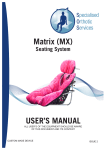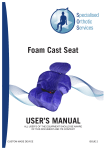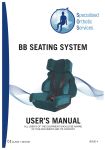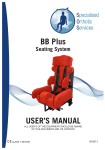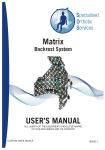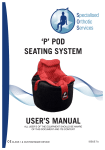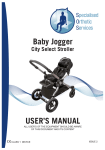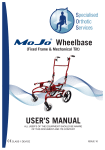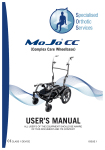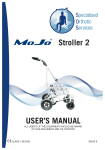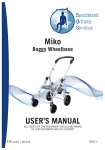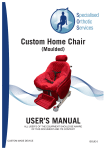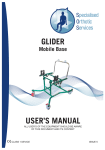Download USER'S MANUAL Moulded Seat Insert (M.S.I.)
Transcript
Moulded Seat Insert (M.S.I.) USER’S MANUAL ALL USER’S OF THE EQUIPMENT SHOULD BE AWARE OF THIS DOCUMENT AND ITS CONTENT CUSTOM MADE DEVICE ISSUE 5 Specification of the Seating System supplied. • • Specified below are the details of the equipment supplied. On the list each item ticked is a part of your Seating System and opposite each item is the reference of the relevant section in this user documentation for that item. Seating System Reference No. Seating System Type Date Issued: / / Weight of Seating System Kg User Manual Reference Item Tick if supplied No. of Items Supplied Page Section Moulded Seat Insert (MSI) Detachable Liner Adjustable Headrest Adjustable Footrest Cover Detachable Pommel Maximum Client Weight Limit for Seating System Kg Specify any other features; It is recommended that this equipment is only suitable for use; Indoor & Indoor Outdoor Details of wheelchair(s) approved for use with the Seating System. Model of Wheelchair Wheelchair Manufacturers Reference Number 1 Tested at (Specify Angle) Index CONTENTS PAGE Specification of Seating System 1 Index 2 Introduction 3 Clinical Review 3 Stability of Wheelchair and Seating Systems 4 Recommendations on Transport 5-8 1.0 User’s Guide “Fitting the MSI to the wheelchair” 1.1 Locating the MSI Frame 9 - 11 1.2 MSI Cover 12 1.3 Electric Wheelchair Use 12 1.4 Maintaining the Wheelchair 12 2.0 User’s Guide “Lifting and Handling the Client” 2.1 Lifting and Handling the Client in and out of the MSI 13 2.2 Client Straps, Harnesses 13 2.3 Footrest Adjustment 13 3.0 User’s Guide “Maintenance of the MSI” 3.1 Cleaning the MSI 14 3.2 Cleaning the MSI Covers 14 3.3 Harness, Pads & Straps 15 3.4 Visual Inspection 15 3.5 Fire Retardancy 15 4.0 User’s Guide “Optional Features” 4.1 Adjustable Headrest 16 4.2 Adjustable Footrest 16 & 17 4.3 Detachable Pommel 17 If You Detect a Fault or Breakage 18 CONTACT DETAILS 2 Backpage MOULDED SEAT INSERT (M.S.I.) Introduction • • • • • • • • • (Custom Made Device) This Users Guide for the Moulded Seat Insert (M.S.I.) is designed to give guidance on its use and maintenance. The Moulded Seat Insert is custom made to suit an individual clients postural requirements. Each MSI is manufactured for a particular individual and must not be used to seat anyone else. The MSI gives overall postural support so the clients weight is evenly distributed over a large area. This improves comfort and should reduce pressure problems. The MSI is also manufactured for use with a particular wheelchair or buggy. To make sure that placing the MSI in the wheelchair does not render it unstable, each MSI supplied is tested for stability and a Certificate of Compliance is issued to verify that the level of stability is satisfactory (for more details regarding stability of wheelchair & seating systems, see page 4). It is recommended that initial use of the MSI by the client after hand over is closely monitored for the first few days. Particular attention should be given to checking the client for any signs of pressure areas, which appear to be caused by sitting in the MSI. If there is any indication of any abnormal pressure areas then refer the client back to the Special Seating Clinic as soon as possible. If the incidence of pressure is very severe then it is recommended that the client stops using the MSI until this can be assessed back at the Seating Clinic. It is recommended that the amount of time a client sits in the MSI is controlled, this will vary due to circumstances, but where possible periods of sitting in the MSI should not exceed more than 3 hours at a time. Removing the client from the MSI is advised after such a period to offer a change of posture. By doing this you will improve a clients tolerance to sitting in the MSI on a daily basis. The maintenance and safety instructions described in the manual must be adhered to. By following these instructions you will be ensuring correct use of the MSI and its safety in use. It is also important to read the ‘Wheelchair User Manual’ with regard to general use, transportation use and maintenance. Clinical Review • To ensure that the Moulded Seat Insert still meets the clinical requirement of the client, • • • it is recommended that the MSI is reviewed by the Special Seating Clinic at least once a year. This may be done automatically by your Wheelchair Service. If a client has had an MSI over twelve months it is recommended that you contact the Wheelchair Service for a review. This will ensure that the MSI is maintaining the clinical needs of the client. If you feel that the client needs to be assessed with regard to any seating needs, then contact your Wheelchair Service. 3 Stability of Wheelchair and Seating Systems • To ensure that the MSI and wheelchair are safe to use, it is important that fitting the • • • • • • • • • MSI to the wheelchair does not make the wheelchair unstable during normal daily use. Each MSI when handed over to the user will be tested for stability to the relevant angle of stability for the chair to be tested. The recommended maximum angle of tilt is 12° for attendant transit wheelchairs and 16° for users of self propelling wheelchairs and 16° for users of electric indoor and electric outdoor wheelchairs. 16° If the client is going to use additional items mounted to the wheelchair or seating system such as communications aids etc., then it is essential that the test be done with these in situ to access their impact on the safety of the wheelchair. Similarly, simple items such as trays need to be in place for the test to take into account all the equipment to be used by the client (see diagram opposite). 12° The stability test is always done with the client seated in the seating system and all equipment to be used by the client on a daily basis when in the wheelchair in situ. The combined client Seating System and wheelchair assembly is tested to the specified maximum angle of tilt. Once the test has been successfully completed, a Stability Certificate will be issued by Specialised Orthotic Services Limited. A copy of this certificate will be handed over when the equipment is supplied and should be kept with the user manual for future reference. The MSI is not to be used with any other wheelchair(s) than those for which it has been stability tested and proven safe for use. Always steer clear of obstacles where possible. When using the equipment never attempt to climb or descend an incline where the surface is rough, wet or slippery (gravel, loose chippings, grass, rain, ice, snow, etc). If the equipment is to be used in an electric wheelchair then read carefully the wheelchair manufacturers instructions with regard to safety. WARNING: Whilst the client is seated in the wheelchair, the attachment of any heavy object to the wheelchair (i.e. shopping bags etc.) will have a serious effect on the overall stability of the wheelchair and may place the safety of the client at risk. 4 Recommendations for the Transportation of SOS Seating Systems The following information is intended to give guidance with regard to the use of SOS Seating Systems by wheelchair users and carers during transportation. • Specialised Orthotic Services Ltd have carried out extensive investigations into the suitability of our Special Seating Systems for transportation use and has established clear guidelines for users. • Following these investigations the following user information is intended to give guidance to users of SOS Seating Systems regarding the use of the equipment during transportation. • All SOS Seating Systems are prescribed via Special Seating Clinics and during the assessment process the wheelchair to be used with the Seating System will be identified. • As part of the assessment process, transportation requirements will be assessed and a suitable wheelchair prescribed for use with the Seating System. This information will be of interest to all parties involved in the daily management of the wheelchair user (Relatives, Carers, Support Staff, Healthcare Professionals and Transport Service Providers). 5 General Safety Guidelines for Wheelchair User Transportation • • Wheelchair users should transfer to vehicle seats whenever possible. • There should be sufficient free space around the wheelchair and user to avoid the user making contact with other vehicle occupants, unpadded parts of the vehicle, wheelchair accessories or W.T.O.R.S. anchor points. • • • • • Wheelchair users should not travel with the wheelchair at an angle or facing sideways to the direction of travel. Wheelchairs should have the parking brakes applied and their power units switched off during vehicle movement. Powered wheelchairs should not be left in free wheel mode. Wheelchairs should not block gangways and exits for other passengers in the vehicle. A headrest should be provided for a wheelchair user when travelling in a vehicle where other seated passengers have headrests. Do not place / hang any additional items onto the wheelchair during transportation such as shopping bags and holdalls. Trays should be removed for transportation whenever possible. If it is necessary for a tray to be used on transportation, then a risk assessment should be done. Wheelchair Tie Down and Occupant Restraint System (W.T.O.R.S.) • • Secure methods for the safe retention of wheelchairs have been developed and are used on a regular basis to secure wheelchairs during transportation use. These systems are now commonly referred to as W.T.O.R.S. Wheelchair Tie down and Occupant Restraint Systems • • There are many types of W.T.O.R.S. available from various manufacturers, a list of some manufacturers is given on page 8). Refer to your Wheelchair Manufacturers Handbook for details of their particular recommendations. Please note that all lap /chest belts and harnesses supplied with the seating system are not sufficient for occupant restraint when the equipment is used on a moving vehicle and additional Occupant Restraint is required. 6 Use of Seating System in a Wheelchair for Transportation To make sure that the seating system and wheelchair are used effectively and safely for transportation use, the following recommendations are provided for: • • • The Seating System - Wheelchair Interface The Wheelchair Tie down System The Occupant Restraint System 2. WHEELCHAIR TIE DOWN SYSTEM • • • Wheelchair users should not travel in cars, taxis or minibuses, unless the wheelchair is tied down. Please refer to your wheelchair users guide for information regarding the recommended wheelchair tie down system to be used. Only the wheelchair specified for use with the seating system can be used. 3. OCCUPANT RESTRAINT SYSTEM • • • • • • Wheelchair users should not travel in cars, taxis or minibuses, unless an occupant restraint system is in place on the client. For any client to be transported safely in the Seating System and wheelchair, it is essential that an Occupant Restraint System be used. SOS have proven during crash tests on MSI’s that transporting any client on a moving vehicle without an approved occupant restraint system is extremely dangerous and will place the client at great risk. It is important that the Occupant Restraint System is positioned correctly as most clients using Special Seating will be dependent on carers for correct placement of the occupant restraint. Consideration should be given to the most suitable type and positioning of restraint for the user, both in normal travel and during an impact. The Occupant Restraint should have a clear path from the user to the anchor point and should not be interfered with by any part of the vehicle, wheelchair, seating or accessory. 7 Stowage of the Seating System and Wheelchair • • • • During use of your Special Seating System it may be necessary for you to remove the Seating System and stow this along with the wheelchair in a vehicle. It is important to realise that these items pose a risk if not adequately restrained whilst in transit. It is not adequate to simply place the items into a car boot or the floor of an open vehicle such as an MPV or estate car as in a collision these unsecured items could cause serious injury to occupants of the vehicle. Various retention methods are available to secure such equipment during transit, and once again the list of Wheelchair Restraint System Manufacturers in this booklet will be happy to advise on this matter (see below). W.T.O.R.S MANUFACTURERS Below are details of some Wheelchair Tie down and Occupant Restraint Systems manufacturers. UNWIN SAFETY SYSTEMS Unwin House The Horseshoe Coat Road Martock Somerset TA12 6EY KOLLER ENGINEERING LTD Unit 5, Garrett Road Lynx Trading Estate Yeovil Somerset BA20 2TJ QSTRAINT (EUROPE) Unit 175 TEL: 01227 773035 John Wilson Business Park FAX: 01227 770035 Whitstable E MaiI: [email protected] Kent CT5 3RB SAFETEX Unit 16 / 17 Bookham Industrial Park Church Road Bookham Surrey KT23 3EU TEL: 01935 827740 FAX: 01935 827760 E Mail: [email protected] 8 TEL: 01935 426695 FAX: 01935 433766 E MaiI: [email protected] TEL: 01372 451272 FAX: 01372 451282 E Mail: [email protected] USER GUIDE 1.0 THE SEATING SYSTEM WHEELCHAIR INTERFACE • The MSI will have been built to suit the wheelchair specified at the assessment. The method of interfacing the seat may vary and the 2 types of interface options are described in this section. 1.1. LOCATING THE MSI SEAT FRAME CANVAS FITTING INTERFACE METHOD If the MSI has been set up to interface on the existing wheelchair canvases then the following method is used to install and remove it from the wheelchair. • • • • • • • Whilst holding the MSI, place this into the wheelchair making sure that the front bar on the support frame locates behind the armrest upright posts (Fig.1.1a) or into the ski brackets (Fig.1.1b). Having located the seat behind the armrest uprights gently lower the back of the seat onto the wheelchair backrest canvas. The seat will now be able to sit into the wheelchair. The seat retention straps now need to be fastened around the back of the wheelchair. Seat Retention Straps are secured around the back of the wheelchair frame, not just the wheelchair canvas (Fig.1.1c). With the MSI now installed into the wheelchair it is now safe to place the client in position. Fig.1.1a S.O.S. Seating Systems need to be interfaced to the wheelchair safely and it is important that the retention straps are always secured for client safety. Removing the MSI from the wheelchair is the reverse of the above procedure. Fig.1.1b Fig.1.1c 9 HANGER BRACKET INTERFACE METHOD If the MSI has been set up to interface into the wheelchair with Location Hanger Brackets then the following method is used to install and remove it from the wheelchair. • • • • • • • • • Firmly holding the MSI lower it into the wheelchair. As you lower the seat into the wheelchair please note that under the support frame on the seating system you will see some additional brackets, these are the Location Hanger Brackets and are intended to sit onto the seat rails of the wheelchair. Gently lower the seating system into position making sure that the Hanger Brackets locate on the seat rails (Fig.1.1d). Having lowered the seat onto the seat rails and located the Hanger Brackets the rear of the seat needs to locate onto the back of the wheelchair. Slide the seating system back on the seat rails until the rear Location Hanger Bracket sits against the backrest of the wheelchair. Fig.1.1d With the seating system Hanger Brackets located on the seat rails and the backrest posts of the wheelchair it is now necessary to slide the Hanger Bracket lock tubes into position where fitted (Fig.1.1e). With the locking tubes in position tighten the locking screws to secure permanently. Having attached all the hanger brackets into position as described above all that remains to be done is to fit the rear retention strap (on the support frame of the seating system) around the back of the wheelchair and secure in position (Fig.1.1f). Fig.1.1e The seat is now ready to use. Special Seating System Restraint Straps must always be in position and tightened firmly. This is essential during transportation of the client, to ensure client safety. Check tightness of these straps regularly. loose straps are potentially dangerous and may not secure the MSI properly. Fig.1.1f To remove the seating system from the wheelchair simply, reverse the above procedure. 10 QUICK RELEASE (Quick-Loc) INTERFACE METHOD • • • • • • • Whilst holding the MSI, place this into the wheelchair making sure that the front of the interface frame locates into stops as shown (Fig.1.1g). Lower the back of the seat into the wheelchair until the interface locates into the rear catches as shown and it clicks into position (Fig.1.1h). Secure the Seat Retention Strap around the back of the wheelchair frame, not just the wheelchair canvas (Fig.1.1j). With the MSI now installed into the wheelchair it is now safe to place the client in position. Fig.1.1g S.O.S. Seating Systems need to be interfaced to the wheelchair safely and it is important that the retention straps are always secured for client safety. Before removing the MSI, SOS recommend that the client is removed from the seating system. To remove the MSI from the wheelchair, release the retention strap, pull back the interface lever or cable (Fig.1.1k) until the catches release, raise up the rear of the interface clear of the catches, release the lever and pull the interface clear of the front stops. Fig.1.1h Fig.1.1j Fig.1.1k 11 1.2. MSI COVER • If the MSI is fitted with a cover, check that the cover fits neatly. • Every time a cover is made for the MSI a pattern is kept. Therefore if any duplicate covers are required, these can be easily made without the need to see the client or the MSI. Contact your Wheelchair Service or SOS (see back page for details) for further details. 1.3. ELECTRIC WHEELCHAIRS • When fitting the MSI to an electric wheelchair, the fitting procedures are the same as • in 1.1 and 1.2. However it is also necessary to make sure that any electric cables etc., are not trapped or jammed by the MSI during placement into an electric wheelchair. 1.4. MAINTAINING THE WHEELCHAIRS • It is important that the wheelchair manufacturers guidelines for maintenance are • • • • carried out. Under inflated tyres or faulty brakes etc. can render a wheelchair dangerous if used with such faults. All new wheelchairs are supplied with a copy of the manufacturers user instructions. You should have a copy of the Wheelchair Manufacturers User Information. If you do not have a copy, contact your Wheelchair Service to obtain a copy. Always maintain your wheelchair as per manufacturers instructions. 12 USER GUIDE 2.0 2.1. LIFTING & HANDLING THE CLIENT IN & OUT OF THE MSI • Most users of MSI’s will need to be hoisted into the equipment. Manually lifting • • • • • • the client is not recommended, however with some clients it may not be possible to hoist them safely by conventional means and in instances such as this you are recommended to carry out a ‘RISK ASSESSMENT’ to assess the risks involved in any such action. It is important that all carers are aware of the Health & Safety guidelines for ‘Lifting and Handling’. Before lifting the client make sure all straps are placed out of the MSI. This will avoid the straps becoming trapped under the client when seated. When using the hoist, make sure that you follow the hoist manufacturers instructions regarding correct use. On lowering the client into the MSI make sure that the client’s hips / pelvis are located as far back as possible into the MSI. Leaving the hoist sling in the MSI once the client has been placed is not recommended as this could cause discomfort and pressure areas to be generated. However, if any management issues require the sling to be left in situ, then it is recommended that the most appropriate sling be used. If you require further information regarding this, contact your local Wheelchair Service Therapist. Please note, that it is very important that the client is correctly positioned to give maximum comfort and support. 2.2. CLIENT STRAPS / HARNESSES • Secure all straps / harness supplied. Straps and • • harness must be tightened to work correctly. If the MSI has been fitted with a ‘Butterfly X Harness’, it is important that it is correctly adjusted to maintain safe clearance at the top of the harness as illustrated in the diagram opposite at ‘X’. 2.3. FOOTREST ADJUSTMENT • It is recommended that feet be supported on the foot • • ‘X’ It is dangerous to have straps too loose or not in place on the client. supports provided to ensure that the client is seated with optimum comfort. Leaving the clients feet unsupported is not recommended as this can lead to great discomfort and abnormal pressure being generated at the pelvis and other weight bearing areas. It is therefore essential that the footrests of the wheelchair be adjusted correctly (see Wheelchair User Manual for details). 13 Keep bottom straps of harness tight. USER GUIDE 3.0 MAINTENANCE OF THE MSI To make sure that the MSI remains satisfactory it is necessary to carry out simple maintenance. 3.1. CLEANING THE MSI • During use the MSI will require cleaning. This can be done by simply applying a warm • • • • • damp cloth with a mild detergent to the inside surface of the MSI to remove any soiling and towel dry. Note: The cover MUST be removed prior to any cleaning of this MSI. If the MSI remains slightly damp simply leave for a short period at room temperature to dry. The MSI is manufactured from a closed cell foam which does not absorb water. To clean the outside of the MSI simply wipe down with a warm damp cloth (a mild detergent may be used) and wipe dry DO NOT PUT THE MSI NEXT TO A HOT FIRE OR USE EXCESSIVE HEAT TO DRY AS EXCESSIVE HEAT COULD AFFECT THE SHAPE OF THE SEAT. DO NOT USE SCOURERS OR CAUSTIC SUBSTANCES SUCH AS BLEACH. 3.2. STRETCH COVERS • If the MSI has been supplied with a cover this may require occasional cleaning, for • • • cleaning of removable cover please refer to wash label on the inside of the padded cover. To remove the cover simply stretch off the moulded seat, taking care to guide any straps etc. through the cover before removing. When placing the cover back on the MSI after cleaning, please note that the inner label should be positioned at the top of the seat to ensure correct alignment of the straps and general fit into the MSI. ANY DEVIATIONS FROM THE ABOVE MAY AFFECT THE FIRE RETARDANCY OF THE COVER(S). 14 3.3. HARNESSES, PADS & STRAPS • Make sure all straps are in good working order and that buckles work correctly. • If any show signs of fraying or any buckles are broken or faulty contact your • Wheelchair Service immediately, DO NOT ATTEMPT TO REPAIR. Harnesses may be cleaned by applying a warm damp cloth with a mild detergent, DO NOT USE POLISH. 3.4. VISUAL INSPECTION • Every 3 - 4 weeks check the condition of the MSI and wheelchair, if you notice any • • faults or broken parts please notify your Wheelchair Service immediately, DO NOT ATTEMPT TO REPAIR. Look at the tubular frame of the MSI and make sure there are no signs of distortion, make sure it is securely attached to the moulded shell of the seat and there are no loose attachments. Check the moulded shell of the seat for any signs of severe wear and tear. Also the foam lining of the seat. 3.5. FIRE RETARDANCY • Fire retardant materials have been used in the construction of this seating system. • It is important that no accelerants are introduced to the materials (e.g. Hairspray, fabric cleaners, deodorants, polish etc..), as this may adversely affect the fire retardancy of your equipment. 15 USER GUIDE 4.0 OPTIONAL FEATURES 4.1. ADJUSTABLE HEADREST • • • If the MSI has been fitted with an adjustable headrest, the headrest will have been adjusted when the MSI was originally supplied. If any adjustments need to be carried out this can be done by releasing the locking knobs and adjusted for height (Fig.4.1a) and depth (Fig.4.1b), re-tighten locking knobs when finished. PLEASE NOTE THAT SOS RECOMMEND THE HEADREST IS USED AT ALL TIMES WHENEVER THE CLIENT IS BEING TRANSPORTED IN THEIR WHEELCHAIR AND SEATING SYSTEM. Fig.4.1a Fig.4.1b 4.2. ADJUSTABLE FOOTREST • If the MSI has an adjustable footrest, it is • • • important that the feet are well supported (Fig.4.2a) and the footrest positioned correctly. The footrest will have been correctly adjusted when the equipment was handed over in clinic as opposite. The footrest is adjustable for height (Fig.4.2b) and reach (Fig.4.2c). If the MSI has been set up for use with the standard wheelchair footrests, then these will be adjusted correctly when the equipment is handed over in clinic. Adjustments can easily be done to the footrests if necessary (see the wheelchair manufacturers user information for more details). Fig.4.2a If the MSI has been set up to use an integral footrest (Fig.4.2a), then the wheelchair footrests are not to be used. 16 Fig.4.2b Fig.4.2c 4.3. DETACHABLE POMMEL • If the MSI has a detachable pommel this is secured in place by either a wing knob underneath the seat or a locking knob at the front of the pommel. Wing Knob Underneath: • • To remove/adjust, turn the wing knob (Fig.4.3b) underneath the seat anti-clockwise to release. The pommel can then be withdrawn/adjusted (Fig.4.3a) and re-tightened when in position. Re-fitting is a reversal of the above procedure. Fig.4.3a Locking Knob at Front: • • To remove/adjust, turn locking knob (Fig.4.3c) at the front of the bracket anti-clockwise to release. The pommel can then be withdrawn/ adjusted (Fig.4.3a) and re-tightened when in position. To replace simply insert bracket stem back into the square socket, slide into desired position and lock into place, turning the lock knob clockwise until secure making sure that the barrel lock is correctly positioned as shown (Fig.4.3c). Fig.4.3c Bracket Barrel Lock Lock Knob Fig.4.3b Lock Nut Threaded Rod You can identify all the relevant parts supplied with your MSI Seat by referring to Page 1, “Specification of the Seating System supplied”. 17 IF YOU DETECT A FAULT OR BREAKAGE 1. IF YOU DETECT A FAULT OR BREAKAGE OF THE EQUIPMENT THEN REPORT THIS IMMEDIATELY. 2. UNDER NO CIRCUMSTANCES ARE ANY MODIFICATIONS / ALTERATIONS TO BE DONE BY ANYONE OTHER THAN SPECIALISED ORTHOTIC SERVICES LTD (see contact details enclosed). 3. TO CONTACT SPECIALISED ORTHOTIC SERVICES LTD PLEASE REFER TO THE INFORMATION INCLUDED IN THIS USER MANUAL. REPAIRS & SERVICE Within the warranty period. All Seating Systems manufactured by Specialised Orthotic Services Ltd. carry a guarantee on the main parts for 12 months, excluding covers and straps which are guaranteed for 3 months, when used normally. If during this period the product becomes defective and needs repair then please contact SOS (please see the end of this users guide for details). You can also contact your local wheelchair service regarding any faults requiring attention. Outside the warranty period. For any goods requiring repair or attention after the guaranteed period, then assessment can be made as to the cost of the work required to effect the repair. On acceptance of this quotation the work will proceed. Misuse or neglect. The repairs necessary resulting from misuse or neglect, whether within the warranty period or not will be charged for. MEDICAL DEVICES DIRECTIVE 93 / 42 EEC Specialised Orthotic Services Ltd. in compliance with the Medical Devices Directive have an obligation to investigate and take corrective action on defective devices. To assist us with this procedure we would appreciate your assistance in meeting this obligation by informing us as soon as possible and make the device available for inspection as soon as possible having become aware of a defect. We are required to notify the Competent Authority of certain types of incidents within 10 to 30 days. As part of our quality system we have established procedures to deal with such incidences and would appreciate your swift notification to us via our telephone, fax or e-mail details at the end of this users manual. 18 If you require further copies of this handout or require further details relating to any of its content, then please contact us (Copyright applies): Units 127/128, Fauld Industrial Park, Tutbury, Staffordshire. DE13 9HS Tel: 0044 (0)1283 520400 Fax: 0044 (0)1283 520401 E-mail: [email protected] Web: www.specialisedorthoticservices.co.uk




















